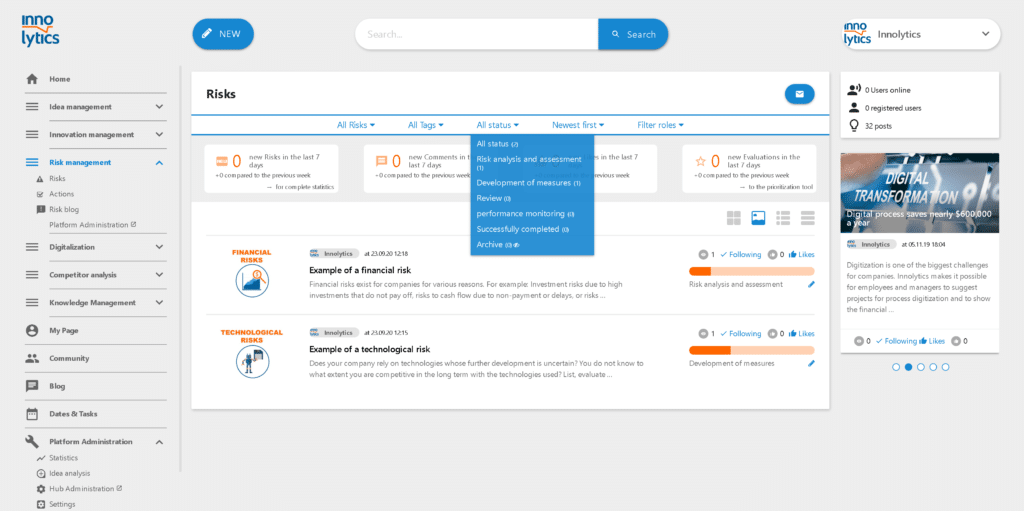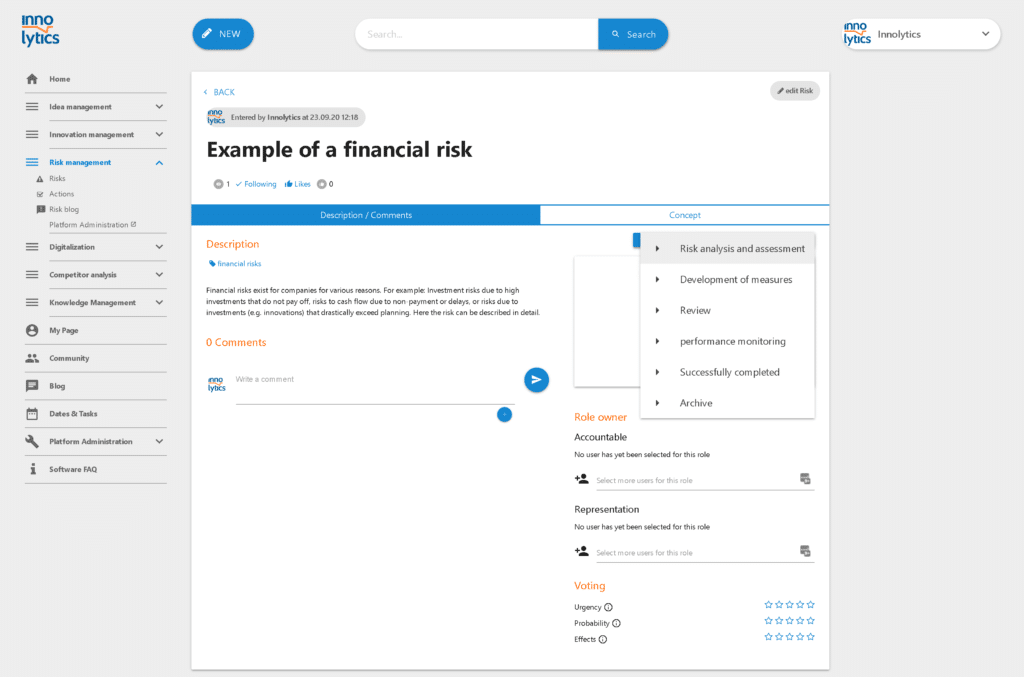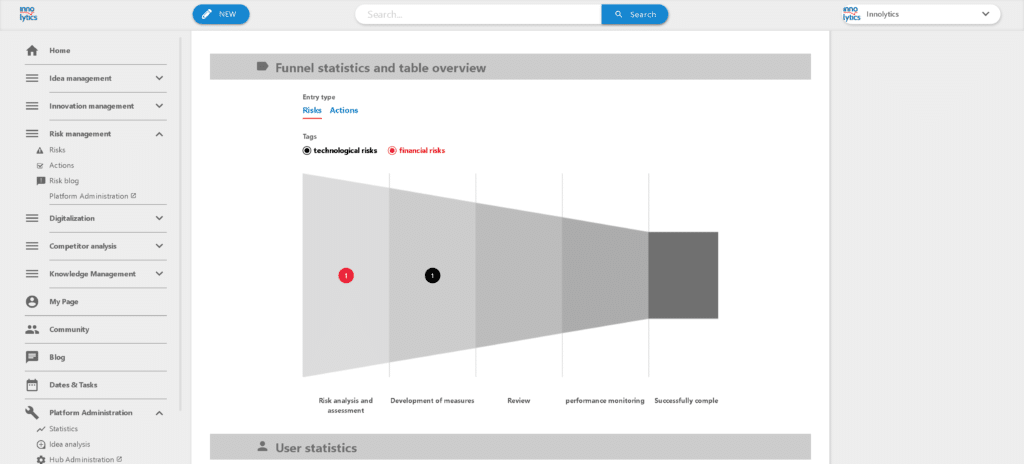What is risk management software?
Risk management software helps companies to identify and assess risks to their business processes and business model and to derive the necessary measures.
In this article, you will learn about the most important functions of risk management software, the areas of application, and the advantages. And you will learn what role such tools play, for example, in ISO-Certification according to ISO 9001:2015.


What is risk management software?
Risk management software helps companies to identify and assess risks to their business processes and business model and to derive the necessary measures.
In this article, you will learn about the most important functions of risk management software, the areas of application, and the advantages. And you will learn what role such tools play, for example, in ISO-Certification according to ISO 9001:2015.
Risk Management Software Definition
Managing risks in the company is one of the core contents of the ISO 9001:2015 standard. ISO 31000 is another standard that deals with risk management. Companies that want to obtain certification according to these two standards must demonstrate an established risk management process. The use of risk management software offers advantages here.
Risk management software is an Enterprise software, with which companies, organizations, and associations can enter, discuss and evaluate risks. Based on this, measures can be developed to mitigate the risks. The implementation is done through a transparent risk management process.
Risk Management Software Advantages
Managing risks is one of the most important business tasks. It is essential for the maintenance and smooth running of business operations. Risks can arise, for example

- through defaulted payments,
- trough product malfunctions,
- legal conditions and regulations, or from sudden
- events such as natural disasters.
Risk management software helps companies take in potential risks from different business areas, assess the potential threat to business operations, and develop measures to address the risks. Risk management software that relies on the principle of collaboration allows employees to enter risks at any location in the world and any department.
There are advantages to using risk management software:
- It allows companies to evaluate risks according to a predefined standard,
- manage risks with a clear transparent process,
- develop measures to mitigate the risks, and
- monitor the effective implementation of these measures.
Risk management software also provides companies with reporting on identified business risks and their potential impact. Reporting can also be used to monitor the implementation of measures and thus the achievement of objectives.
Risk management software functions
What functions are important in risk management software? Roughly speaking, the functions can be divided into three areas: the collection, evaluation, and prioritization of risks, the development of measures, and the control of implementation. You will learn about these three functional areas here:
Entering, assessing, and prioritizing risks
Risk management software allows you to enter risks and evaluate them according to criteria such as “probability of occurrence” and “impact”. With a transparent process, the management of risks can be simplified.
The Risk Management Software module of the Innolytics® Software Suite makes exactly that possible. Companies can enter risks, evaluate them according to criteria they can define themselves, and use a prioritization tool to identify the greatest risks in the various areas.

Development of measures
Risk management software also helps companies to
- develop measures to mitigate or eliminate risks,
- assign responsibilities, and
- define tasks and milestones for implementation.
Here, too, a clear process with different processing steps ensures that the implementation of measures can take place transparently and efficiently. The risk management software module of the Innolytics® software suite also supports this process.
Developing risk management monitoring
Risk management software provides answers to questions like these:
- How many risks have been newly identified in a certain period?
- How many risks are in which position in the process?
- How much is risk management accepted and lived in the daily routine of a company?
The statistics functions of risk management software ensure that companies always have an overview of all risk management activities.

Areas of application/use cases for risk management software
As different as the risks within companies and organizations are, as different are the areas of application for risk management software. Risks can arise, for example
- within production,
- in a supply chain,
- regarding compliance issues,
- in personnel acquisition,
- through new trends, and
- through competitor activities
Accordingly, risk management software can be used in all areas. Since risks are often just the flip side of opportunities, risk management software has a close overlap with Innovation Management Software.

Risk management software in the supply chain
Companies – especially manufacturers of products – depend on a smoothly functioning supply chain. Risks can arise, for example
- in the sudden price increase of raw materials,
- by the failure of one or more suppliers, or
- natural disasters and thus a sudden shortage of certain raw materials.
Risk management software in the supply chain helps to identify and evaluate such risks at an early stage and to take countermeasures.
For example, purely based on price advantage, it may make sense to source supplies exclusively from abroad. In terms of risk management, strategic second suppliers can make sense, even if they may produce more expensively. Establishing a software-supported risk management system helps to make such decisions.

Risk management software to identify market risks
Trends such as digitalization, a sudden change in customer behavior, or a marketing offensive by competitors can result in the loss of market share for companies. They, therefore, represent risks. Risk management software helps companies
- identify such risks at an early stage,
- assess the impact of these market risks, and
- develop measures for the product or marketing strategy.
The consideration of market risks can lead to the development or modification of products or the development of new business models Development of digital business models can also be carried out from the perspective of risk avoidance.

Risk management software in Human Resources
There are also numerous risks for companies in recruitment. For example, if
- attractive competitors settle in the region,
- the number of trainees in an area that is important for the company declines, or
- the company has more difficulty gaining access to skilled workers due to the poor image of the industry,
risk management software helps to identify these risks at an early stage, evaluate them and take countermeasures. Since causes for risks in recruitment are often located in other areas, a software-supported management system helps to establish cross-divisional risk management.

The Innolytics® Risk Management Software Module
The Innolytics® Management Systems Software includes a variety of modules that help companies address strategically important challenges. The Risk Management Software module allows companies to record and assess risks and take countermeasures.
- Risk management can be mapped in a structured process.
- Persons responsible for the analysis and for implementing measures can be named.
- All risks can be linked to initiatives for innovation or measures, like the continuous improvement process.
The risk management software module allows companies to enter and evaluate risks across divisions. By linking it to other strategic processes, companies can integrate risk management holistically into their corporate structures.